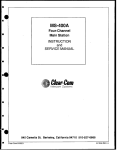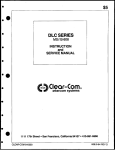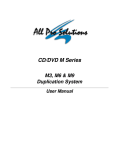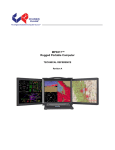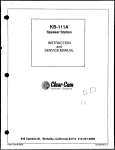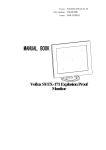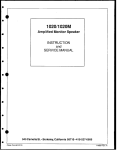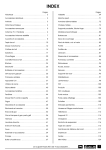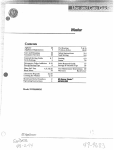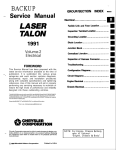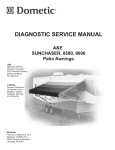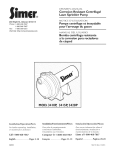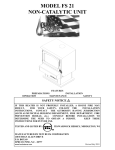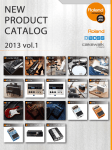Download SB-412A lilliClearmComn - Clear-Com
Transcript
SB-412A Switchboard Main Station INSTRUCTION and SERVICE MANUAL lilliClearmComn Intercom Systems 945 Camelia St. Berkeley, California 94710 510-527-6666 Clear-Com 810023 10/85 REV. A ttsts*t*t**t*tt*t**tt***t*tt**ttt*t*tt****tt***tttttt*t* ** DOCUMENTATION ADDENDUM SB-412A MANUAL REV.A November 17, 1987 tttttttttt*tt*******t*ttttti*i***tttit**i~tttt**t*ti ** i* *a tint MIC TO LINE GAIN LEVEL INCREASE In effecting a 4dB Mic to Line increase in gain level, following changes have been made: Change: At: To: 22K OHM R126, 109 100, 91 39K OHM 4.7K OHM R45 6.8K OHM the SB-412A Installation S Operation Manual 1. * INTRODUCTION A. Clear-Com Concept ............. I B. SB-412A Description ........... 2 II. INSTALLATION A. Maximum Number of Stations....3 B. Interconnect Cable............4 C. System Architecture. 7 0. System Wiring. 8 E. Mounting the Station .16 F. Station Connection .16 G. Set-Up .16 H. Headsets & Mics. 18 i. System Check .18 * *@ *A. 111. OPERATION Quick Guide .19 B. Operating Controls .21 C. Special Features: ISO, IFB, Split-Feed .24 IV. TECHNICAL INFORMATION A. Circuit Operation .25 8. Maintenance & Warranty . 26 C. Troubleshooting .27 D. Specifications .29 E. Parts Lists .30 F. Component Locations .33 BLOCK DIAGRAM £ SCHEMATICS.. 35 i* fO rice: "Thile Clear-Comr makes every attempt to maintain the accuracy of the 'Wnformation contained in its product manuals, the information is subject to change without notice: 1. INTRODUCTION 1. A. The Clear-Corn Concept Clear-Com is a closed-circuit intercom system that consistently provides highclarity, two-way communications in highnoise and low-noise environments. A basic system consists of a single- or multi-channel power supply or main station connected to various single- or multi-channel remote stations. Clear-Com manufactures a wide variety of both portable and fixed-installation units. All are compatible with each other (Clear-Com can also interface with other communication systems; see Section IID or ask your dealer for details). Clear-Com stations are interconnected with two-conductor, shielded microphone cable, using 3-pin XLR connectors. One wire carries the DC power (28-30 volts) from a main station or power supply to all remote stations, and the other wire carries audio information. The shield acts as a common ground. Only one termination is needed throughout the intercom network, and is located in a main station or power supply. Clear-Com is a distributed amplifier system; each main and remote station houses its own mic preamplifier (for headset or speaker) and signalling circuitry. The Automatic Headset Detection circuit shuts off when any station's mic preamp is disconnected, so background noise on the line is not increased by an unused yet on-line station. Low-impedance mic input lines (200 ohms) and specially designed circuitry make ClearCom channels virtually immune to RFI and dimmer noise. Clear-Com main stations, power supplies, and certain remote station each have an auxil iary program input with its own volume control, which allows an external source to be fed to the intercom system. Visual Signal Circuitry, a standard feature on most main and remote stations, allows the user to attract the attention of operators who have removed their headsets. Depending upon the type of main and remote stations selected, a maximum number of remote stations from 13 (all speaker stations) to 100 (all headset stations) can be distributed along a mile of wire. Remote stations bridge the intercom line at a very high impedance, and place a minimum load on the line. Audio level always remains constant, and does not fluctuate as stations leave or join the network. The 28-30 volts DC provided by main stations and power supply units enable remote stations to operate with minimal current (10 milliamperes quiescent for headset stations, 20 mA quiescent for speaker stations) while generating extremely loud listen volumes (greater than 110 dB SPL). The higher voltage and low current keep voltage losses to an absolute minimum in long lines. If the voltage drops due to the addition of great lengths of cable or many more stations, Clear-Com equipment will continue operating with less than 12 volts available. 1. B. SB-412A Description The SB-412A is designed for applications in which a person needs to communicate with up to four other people or groups of people and be able to quickly change any remote station's channel assignment from the front panel. The SB-412A's four main intercom channels can be accessed either individually or simultaneously, while still maintaining isolation between channels. Controls that are recessed bepanel. hind the front panel are normally used only during installation and set-up. The sB-412A is self-powered, and can also power up to 20 speaker stations or 100 headset stations. It is normally used as a main station (which provides system termination at a central location), but may be used also as a remote station that provides extra power capac i ty. Access to the four main channels is controlled by the row of pushbutton and toggle switches along the bottom right Separate conside of the front panel. trols for talk and listen for each channel enhance the station's versatility. The twelve switchboard inputs are individually assigned to one of the four main channels or to an isolated OFF position, via the matrix switches on the left half of the front panel. On the SB-412A rear panel, one XLR connector for each of the four channels and the twelve switchboard inputs allows easy connection to the rest of the system. A program (auxiliary) input on the rear panel allows an external program to be monitored at the station and/or sent on one (or more) of the intercom channels. Its preamp gain is switchable for An external mic- or line-level inputs. speaker jack is also provided. Controls which affect the input and output at the station (mic, headsets, speaker, and program) are located in a row along the upper right of the front Special functions, allowing ISO and IFB, may be set up with internal jumpers. See Section III for a detailed discussion of all controls and jumpers. 2 11. INSTALLATION II-A. Maximum Number of Stations The SB-412A has a maximum output current capacity of two amps; the total current draw on all channels cannot exceed this output. The maximum number of remote stations that one SB-412A will support depends upon three factors: 1) the current requirements of each remote station 2) the cable length 3) the cable gauge Consult the graph below. Match the number of speaker stations in your system to the number of headset stations. If the point reached falls within the shaded section of the graph, one SB-412A will operate the entire system with no reduction in performance. In situations where a significant current drain occurs 1000 feet or farther from the SB-412A, an additional power supply (or main station) or an extra large gauge cable may be necessary to insure sufficient voltage for full output without clipping. Any number of Clear-Com main stations and/or power supplies may be connected in parallel. If your system includes headset stations only, the SB-412A can operate a maximum of 100 units. If your system contains speaker stations only, the SB-412A can operate up to 20 units (note: if all remote stations are RM-400A's, the maximum capacity is 13). if your system contains a combination of headset and speaker stations (typical of most applications), you must determine the maximum system capacity. In all cases, multi-pair shielded mic cable should be used to interconnect all stations. The next Section describes cable requirements in detail. Example: IfI have 100- 40 headset stations, how many speaker stations can my system support? Answer 12 speaker station equivalents (S.S.E.) (I.E. 8 RM-400A s; 12 KB-111A's; or a combination of both. See text for calculation details.). 90- 8070- HEADSET STATIONS \ 60 50Q - 40- - - - - -- 30- 2010 | w , I 0 1 , 2 3 I 4 I I . .r 5 6 7 8 9 10 11 12 13 14 15 16 17 18 19 20 SPEAKER STATION EQUIVALENTS (S.S.E.) A one or two channel station is 1.0 S.S.E.. A four channel station is 1.5 S.S.E. Maximum Number of Remote Stations 3 Il-B. Cable Considerations The SB-412A contains one XLR-type, 3-pin male connector for each of the four main intercom channels and for each of the 12 switchboard lines (total, 16 output connectors). You'll route shielded cable from the rear panel of the SB-412A, then connect it to all the remote stations in the system. Allow 3 inches behind the unit for cables to extend from the rear panel. Avoid sharp bends in cabling. Depending upon your application, you will run separate cables for each channel going to the single-channel remote stations, or two channels (any combination) together to two-channel remote stations (crosstalk considerations discussed later in this section). When choosing interconnect cable, keep the following considerations in mind: 1) DC resistance of the ground or conmon conductor affects crosstalk. In permanent installations, do not use wire smaller than 20 gauge, stranded (except runs shorter than 100 feet). Keep the total resistance of the ground under 2 ohms. 2) The capacitance of the interconnect cable affects the frequency response and sidetone stabilty. Total capacitance should not be greater than .25 microfarads (capacitance between' conductor and shield; equivalent to an intercom system containing 5000 feet of cable at 50 pF per foot). 3) Clear-Corn Systems operate best with cable that has no more than 35 pF from conductor to conductor, and no more than 70 pF from conductor to shield. PORTABLE INSTALLATION CABLE Typical cable for portable system interconnection is rubber-jacketed, two-conductor, shielded microphone cable. We suggest you try BELDEN 8413 (24 gauge, stranded) for connections totalling 500 feet or less, and BELDEN 8412 (20 gauge, stranded) for connections running from 500 to 5000 feet. 4 Portable remote stations such as beltpacks each have a pair of input and output connectors; when installing a system that includes these, you can daisy-chain many stations along one interconnect path. Or, you can use Clear-Com's line splitter (one input, three outputs) to feed individual lines to station inputs (see diagrams on the following pages for various configurations). Daisy-chaining and line splitting decrease the amount of cable required and simplify installation. 46 PERMANENT INSTALLATION CABLE We recommend you use vinyl-insulated and jacketed cable for connections to permanently-installed stations; it costs less and is easier to pull through conduit than the rubber-insulated cable. You must use low capacitance cable. We suggest you try BELDEN 8762 (20 gauge, stranded) for applications up to 500 feet, and BELDEN 8760 (18 gauge, stranded) For up to 5000 feet. a. W If conduit is available when installing permanent remote stations, run interconnect cables through the conduit to each wall- or console-mounted unit. NOTE: chassis ground and signal ground (XLR connector Pin 1) are NOT the same point. DO NOT connect the chassis to Pin 1. The chassis is insulated from the signal ground with a capacitor (.01 microfarad, 1.4 cv). This eliminates the hum and potential shock hazard that can arise if stations are at a different ground potential. In some situations, existing wire in a conduit may be used; consult the factory for guidelines. In installations where conduit is NOT used, and equipment doesn't share a common ground, it is good engineering practice to run an additional ground wire to tie all chassis together (this decreases susceptibility to electrical noise fields). a Hi W --continued-C- If you don't use Belden cable, use a similar type, with wire gauges and capacitance as specified in this manual. The conductors in the cable, especially in longer runs (over 500 feet) must have low DC resistance (less than 15 ohms per 1000 feet; large diameter conductors) and low capacitance (less than or equal to 55 pF per foot of cable--capacitance between conductor and shield). 8725; see multi-channel cable connection diagram on page 6).. Two channel feeds may be routed with a two-pair shielded cable (such as BELDEN 8723). ---------------------------------------Refer to the Belden wire specs on page 6 to ensure that your substitute cable is comparable. Crosstalk When multiple channels are fed to remote stations, the amount of crosstalk is proportional to the amount of DC resistance in the ground return. Two ohms or less resistance is ideal; two ohms will give you 40 dB of isolation. Anything greater than two ohms will increase crosstalk. Each channel must be fed in its own separate shield. MULTI-CHANNEL CABLE CONSIDERATIONS When installing a system that includes multi-channel stations, the channel feeds may be routed individually to each station with separate two-conductor shielded cables OR four channel feeds may be routed together with one fourpair shielded cable (such as BELDEN When connecting four-pair cable between multi-channel stations, all the shields and ground wires should be connected, effectively lowering ground resistance and reducing crosstalk. Refer to the diagram on pages 6 & 9. Also, tie unused wires in your interconnect cable to ground (Pin 1), thereby further reducing crosstalk. II-D. System Wiring Both physical and electrical considerations are involved in determining the best system wiring configuration. The physical aspects center around ease of wiring, whereas the electrical aspects are dictated by performance requirements of the entire system and/or particular stations in the system. The two main electrical considerations for the cable are resistance in the conductors and capacitance between the conductors. BuiId-up of resistance in the results in a loss of sidetone null at remote stations, some level loss from remote stations to the main station, reduced headset/speaker output before clipping, and, in the ground conductor, a serious increase in crosstalk. Build-up of capacitance results in reduced sidetone null at all stations on the line(s) in question, and reduced voice clarity due to excessive highfrequency roll-off. cable There are three main methods of configuring your system wiring (ANY combination of them can be used in one system): o~~~L I H0 ES 1. iEEl I Daisy-Chain This daisy-chain method requires the least amount of cable, but may be impractical because of your facility's physical layout. Also, if a break occurs in cabling, all stations beyond the break are disabled (this problem is solved by the loop-through shown in Method 2): 8SHEBBS Loop-Through 2. Method 2 provides another advantage in that the DC resistance accumulated in the cable is no more than half as great as in the standard daisy-chain arrangement. However, it also results in a cumulative cable capacitance which may be twice as great as Method l's. Hub" 3. This "hub" method is especially useful for belt-packs and situations in which running two cables to the remote stations is cumbersome. The hub method usually results in fairly low cable resistance between stations, but cumulative capacitance is often the highest of the three methods. R~~~~~~~~~~~~~~~~~~~~~~~~~~~~~~~C z ~~~~~~~~~~~~~~~~~~~~~~~~~~~0 <N C w' n) z 0 0Wz -~~~~~~~~~~~~~~~~~~~~~~~~~~>L p ~~~~~~~~~~~~~~~~~~~~~~~~~~~~~~~~~~~~~~~~~~~La.C 0~~~~~~~0C 0~~~~~~~ - -s~ ~ 3 ~ ~ C ~~~ scz~~~~~~~~ 0~~~~~ 0 9~~~~~ Signalling Configurations in Multi-Channel Systems In normal circumstances, the CALL light on a two-channel remote station lights only when someone signals on the channel that station has selected for communication. This is because the Visual Signal travels on the audio line in the form of DC voltage. A simple modification may be made to the the system wiring so that stations which are switched to one channel will respond to a call signal on the other channel. This modification may be applied in both directions, so that all stations will indicate a call signal from either channel, white still maintaining two completely separate intercom channels (diagram shows how Channel A can send signals to Channel 8): N~~~~~~~~~~ Twoa~~rL I I 1 T Le DIODES4) * j t<r *I\ > Lfzt In-Line Isolation In certain applications you may want to isolate conversations in one section of the system. Clear-Com offers Model BA-I In-Line Isolator, which blocks intercom audio while allowing DC voltage to flow to an isolated "leg" of the system. The BA-I allows one channel to support several simultaneous and independent conversations. The main station cannot communicate with the isolated legs of the system. Private local conversations can go on along a common interconnect line without adding great lengths of cable or additional main stations. You may incorporate any number of BA-1 Isolator's, as long as the capacity of the main station is not exceeded by added remote stations. There are a variety of ways to incorporate the BA-I into a system. For instance, you can plug the BA-I directly into a remote station's extension (output) connector, a main station's channel output connector, or between two runs of cable on any channel. This diagram illustrates two ways of isolating any section of your system: 1.IsAOR | STATION I, A, 0 e B ISOLATOR 10L~ 10~~~~~~~~~~~~~~ 0@ e * 0 Interfacing With Other Systems *Clear-Cor's Model AC 10K Universal Interface, Model AC-lOH Telephone Interface, Model IF4-4 TV Camera Interface, and Model TW-12 Two-Wire System Interface allow you to link Clear-Com with virtually any type of communications system. When your existing system is upgraded with Clear-Com equipment, you may continue to use portions of the older system. The AC-lOK and AC-lOH are called "Adapt-a-Com's" and guarantee compatibility with any in-house intercoms and other two-, three-, and four-wire systems. The AC-IOH facilitates on-line communication via standard telephones, and helps you directly communicate with remote locations using two-wire or four-wire dedicated TELCO pairs. 1 "Typical" Four-Channel intercom Systems standard Clear-Com systems for The diagram on the next page shows ''typical" applications. Since your requirements are likely to differ, both the wiring and your choice of stations may vary. SYMBOL KEY: Four-channel speaker station, rack-mount (RM-400A) Two-channel speaker station, wall-mount (KB-lIIA, KB-112) ( Two-channel speaker station, rack-mount (RM-120A) 0 Two-channel headset station, wall-mount (MR-102A) 1> One- or two-channel belt-pack (CP-100, CP-300, RS-IOOA, RS-201) r7 [j Two-channel speaker station, portable (KB-llIAP, KB-112P) Two-channel wall plate (WP-2/wP-6) @ Three-way line splitter (QP-100) - Universal interface (AC-10K or H) EE In-line isolator (BA-1) Single-muff headset (CC-35B, CC-75B) Double-muff headset (CC-55, CC-240B) * D-o Handheld mic, push-to-talk (PT-4) Handset, push-to-talk (Hs-6) 12 ~~ ~ ~ ~ ~ ~ ~ @ I S 412A STAGE MANAGER 1 FLY RAIL 4 3 2 8 7 9 10 A a C D0 MOUNT x ' OPERATO _ E DRESSING _ ROOM 1 DRESSING 12 )[ BELT- ~ PIT HAND To Four-Channel Rack-Mount > Speaker Station In Audio Booth 12 DIMMER ~ ROM MOUNT~~~WUN | STAGE Prornm Feod from ~~~Audio Console 6 5 11 M NEAOST PIT[0OEA < | I ~~~~'ADSET TATI/OUNT S ~zr r uGHTNG r PACK \STATiN DESIGNERtA Mt , WALLFOLLOW < ffi I LlGHTtNr DIRECTOR 1ST DRESSING ROOM 3 2 SPO~~~~~~~~~TS J IPush STAGE to Talkr DOOR * THEATRICALINTERCOM SYSTEM 13 GUARD AT MAIN RECEPTION AREA SECURITY OF OIC 7 1 8 1D 9 11 to-Ti 6= 5 4 3 2 I A SPEAKEA l SB°412A 12_ A WARE- J "VA) MOUSEL WARE. to-Talk ~~~~~~~~~~~~~~~~~~~Push S A . 2 ~~~~~~~~~~~~~~~~~OFFICE WALL ~~~~~~~~~~~~WAL WALL STATION Push-to-Talk MOUNT SEAKER PLATE STATION ENTRANCE (5u>Wo^AULKLTR) _ LEXECUTIVE LOUNGE * MO'UNT ( SPEAKER STATION i~h. MOUNT to- STTO WL talk IPs-oTl Talk PARKING LOT ENTRY (^ _ STTON * WALL PLATES ARE INSTALLED IN VARIOUS LOCATIONS THROUGHOUT CORRIDORS OF BUILDING: ROAMING SECURITY GUARDS CARRY BELT-PACK STATIONS (with headsets) & PLUG INTO WALL PLATES WHERE NEEDED. INDUSTRIAL SECURITY INTERCOM SYSTEM 14 7~~~< C.)x m 0 u z~~~~~~~~~~~. ~E- - CV~~~~~~~C C)~~~~~~U 0 U2~~~~~~ W z P~~~~~~~~~~~oU 0~~~~~~~~~C E-, C~~~C<0 -C~~~~~~~~~~~~~~E E- ~~~~~E -C~~~~~~~~~~~~~~~~~~~~~~~C *15 II-E. Mounting The sB-412A The SB-412A is designed to mount in a standard 19" rack, using 3.5" vertically. It can also mount in a console or sit atop a shelf if necessary. The station extends 9" back from the front panel, but avoid sharp bends in cabling and allow an additional 3" behind the unit. If mounting the station in a console, the cut-out must be very accu- rate, as the front panel extends only a very small amount beyond the top and bottom of the chassis. See next page for mounting dimensions. Before mounting the station, insure that any special features you require have been set up (ISO or IFB operation or split-feed headphones). Il-F. Station Connection Once you determine the configuration of your intercom system, decide upon a location for the main station. Then: 1) Position the unit near a source 115 or 230 VAC (power consumption 80 watts maximum). or all of the thee wiring methods described in Section IID. Pin assignments for the rear panel intercom XLR connectors are: Pin 1, COMMON; Pin 2, +VI)C; Pin 3, INTERCOM AUDIO. of is 2) Use standard multi-pair shielded cable described in Section lIB. 4) Route cables away from heavy AC power sources such as lighting panels or electric motors. 5) 3) Route all cables from the remote stations to the main station. Use any In permanent installations, cables should be installed in accordance with approved local building codes. II-G. Set-Up After connecting the SB-412A to the remote stations, set the channel access (talk presets) and termination switches. IMPORTANT: Before turning on the unit, be sure that the line voltage switch is correctly set, and that the fuse is the proper rating! 16 ~~~~ Next, check that the program gain switch is set to match the level of the ingoing program (mic- or line-level). Finally, adjust operating controls for desired operation and comfortable levels. ~ *- 1 19.00 in. ~ : = 9.5 in. ] / | Allow at least 3.5 in. behind rear panel for XLR connectors 3Iso * | :50 I j 3.23 in. .08 in. more ~~~~~~~~~~~~~~~~~(Allow for top cover screws) in. 16.7 in. 0 MOUNTING DIMENSIONS *0 17 0 IlI-H. Headsets & Mics All headset connectors in Clear-Com gear are the 4-pin, male XLR type. To assure proper level and performance, your headset (or handset or mic) should have the following characteristics-Microphone type: dynamic Impedance: 150-250 ohms Output Level: -SSdBv Ear Element type: dynamic Output Impedance: 300-2000 ohms Model PH-7 is a doubleapplications. muff, high-fidelity headset with very wide frequency response, greater isolation from ambient noise, and extrarugged physical construction. Clear-Com's HS-6 telephone-style handset has a dynamic mic and a push-to-talk switch, and is interchangeable with the above headsets. Our Model PT-4 is a hand-held push-to-talk mic for use with speaker stations. Clear-Com offers three standard headall with boom-mounted, noisesets, Model CC-240B cancelling microphones. is a double-muff headset, and Model CC75B is single-muff; both have boomactivated dynamic mics with built-in Model DT-109/6 is a ON/OFF switches. double-muff headset wired for binaural s All headsets and handsets replaceable cords. have field- An electret element gooseneck microphone, permanently mounted on the SB412A, is available as a factory-installed option. 11-1. Check-Out Connect a headset to the SB-412A and be sure that you can access (talk and listen) all channels needed, and that visual signalling works both to and from The brightly lit button the station. should become dim or go out again immediately after the calling station's Call switch is released. If the light stays bright, there is a problem with the termination in that channel. As a check for proper termination, connect a beltpack to each channel and verify that the voice null occurs at approximately the 4 o'clock position on the trimpot. If the null occurs near or before the 1 o'clock position, there is probably more than In one termination on that channel. units where good sidetone null is important (e.g., where a gooseneck mic and speaker are used simultaneously) this check should also be done for each of the station's sidetone null trimpots. They are located directly behind the unmarked holes next to each "talk" toggle switch. The Stage Announce output should have the station operator's voice on it only while the front panel's "S/Al' switch is engaged. If any channels are fed Program from the SB-412A, the level to each channel may be adjusted using the trimpot(s) behind the access panel. If any special functions have been set up, be sure to verify their operation. S 18 111. OPERATION III-A. Quick Operation Guide 1. Determine which main intercom lines are to be assigned to each channel. Plug connecting cable into the appropriate XLR connectors on the rear panel. Route cables from SB-412A to remote locations and connect it to the inputs of the remote stations. 2. Repeat Step I for the switchboard inputs. Remember that each switchboard input is internally terminated by the SB-412A. So, if any switchboard lines connect to another main station or power supply, switch OFF the termination at that station. 3. If program monitoring is desired, connect the program source to the PROGRAM input on the SB-412A rear panel and set the gain switch to match the source level. Connect a paging amp to the STAGE ANNOUNCE output, if used. Connect a monitor speaker (16 ohms is ideal) is to the EXTERNAL SPEAKER output, if used. 4. Be sure that the rear panel MAINS SELECT switch and fuse are correct for the AC power you're using, then connect the power cord and turn on the POWER switch (the switch will light up). 5. Determine the access methods required for each channel and set the appropriate "talk" DIP switches. Check the settings of the termination DIP switches, and be sure that each channel of every station in the system is connected to one and only one TERMINATION. 6. Plug in the headset or turn on the mic and speaker, turn the SIDETONE volume up to the 10 o'clock position, then carefully adjust the HEADSET or SPEAKER volume for a comfortable level without feedback. 77. Enable communication with each channel using the TALK toggle and/or INTERCOM SELECT switches, and re-adjust the headset or speaker volume if necessary. 8. If applicable, adjust the program level to the station's headsets and speaker using the PROGRAM volume control, and set the level to the intercom lines with the individual trimpots behind the access panel. 9. Check the SIGNALLING functions on each channel. Check operation of any special features and functions needed. 10. See Section IIIC to set up ISO or IFB access SPLIT-FEED headset. operation or 19 0~~~~~~~~~ o > 11 @> n w 121 1 3 t CD~~~~~~~~~~~~~~~~~~~~~l s1 O > cle> rl)~~~N co~ ~ ~ ~~ ~ oC ~ -W\[~~~~~~~~~~~) M -n v j~~~~~~~~~~~~~~~~~~~~~~~~5- CD ME1~~~~~~~~~~~ ~~ 0 ~ ~ ~ ~ Cn~~o ogjv cli 20~~~~~~~~~~~ N) 20~~~~~~~~~~~~~~~~~ 0 C ~~~ ~ ~ ~ ~ ~~c 0 -4~~~~~~~~~~~~~~~~' III-B. SB-412A Operation The controls on the surface of the front panel are used during normal operation of the station; the controls that are recessed behind the front panel cover plate are normally needed only during station set-up. In the following explanation of controls, the boldface numbers in parentheses refer to the diagram of the SB412A on page 18. 0 The SB-412A has two headset connectors (1,2); the mic input of the upper connector is switched by the MIC ON/OFF switch (3) located to its left. When neither headset jack is used, the mic preamp's gain automatically drops to near unity, to avoid noise pick-up from the unused input. (The gain of the switched mic input may be lowered by removing either R-15, 3 dB, or 1T-1, 5 dB. DO NOT remove both.) The headset connector pin-out is: PIN 1-- MIC COMMON PIN 2-- MIC HOT PIN 3-- EAR ELEMENT COMMON PIN 4-- EAR ELEMENT HOT Channel Access The SB-412A operator accesses the desired main channel(s) by using the Intercom Select and Talk toggle switches. Each channel's Intercom Select switch is a push-on/push-off, illuminated switch. It lights dimly while engaged (brightly when a Call signal is received). It always switches the Listen path of its associated channel, and depending on the setting of the Talk pre-set, will also switch the Talk path. The Talk path may always be turned on with the Talk toggle switch, which has both momentary and locking positions. While using the SB-412A, do not position the headsets within two feet of an AC power transformer, or the mics may pick up hum. Switchboard Matrix The twelve assignment switches (28) let you assign the switchboard inputs (29, rear panel) to any one of the four main intercom channels (A, B, C, or D) or an isolated OFF position. If the optional gooseneck mic (1) is installed, it is controlled by the MIC ON/OFF switch. The HEADSET VOLUME (4) and SPEAKER VOLUME (5) controls permit independent adjustment of the intercom audio level in the station's headset and external speaker outputs. If using an external speaker, connect it via the rear panel jack (30). The front panel SPEAKER 0 channel's INTERCOM SELECT button (9) to be programmed for Talk access, as well as the usual Listen access that button controls. These switches are set OFF at the factory, so that Talk access is normally controlled only by TALK toggle switch (10). If the operator requires both Talk and Listen access when the Intercom Select button is engaged, set the talk pre-sets ON for the channel(s) desired. ON/OFF switch (6) allows the external speaker to be muted instantly, without disturbing its volume setting. _ _ _ _ _ _ _ Programming Channel Access The set of recessed DIP switches are labelled "Talk" (8) allows that each When switchboard inputs are assigned to the OFF position, they are isolated from all other switchboard lines and isolated from the four main intercom channels. The only links between the SB-412A operator and the switchboard line(s) in the OFF position are: to the remotes via the All Page function Tdescribed below) or from the remotes via the SB-412A's ''call receive" LED's. Sta e Announce The SB-T12A operator presses the STAGE ANNOUNCE button (11), and audio from the SB-412A's mic(s) feeds to the rear panel S/A connector (12). Normally, the Talk signals to the intercom lines are inter- 21 rupted, but you may add a jumper across the switch to prevent this. All Page When the ALL PAGE button (13) is pressed, the SB-412A operator's voice is sent to all four intercom channels simultaneously, whether or not any channel's Talk access is on. It also feeds the twelve switchboard lines, including those in the OFF position. All Page has no effect on any of the station's other functions. Sidetone Sidetone (the voice of the operator heard at his/her own station) must be carefully controlled to avoid acoustic feedback and/or system instability. The SB-412A has a front panel SIDETONE control (14) to add a set amount of sidetone to the unit's headset/speaker outputs, independent of any channel(s) that the operator is monitoring. Each channel's SIDETONE NULL adjustment (this is located behind the unmarked hole, 15, beside each Talk toggle switch) is set at the factory for best (full) null with less than 500 feet of connected cable. Because of the controlled amount of added sidetone, the number of channels being monitored doesn't have much effect on the overall sidetone level. When you are using a gooseneck mic with an external speaker, it's usually necessary to turn the sidetone control all the way down (counter-clockwise) to prevent acoustic feedback. Depending upon the relative positions of the mic and speaker, it may also be helpful to enable the dipper circuit, which helps prevent feedback. This automatically attentuates the station's speaker output when any of the Talk toggle switches are in the momentary ON position. Termination The termination switches (16) are set only during installation, and must NOT be changed unless a change in system wiring requires it. 22 Program Input The SB-412A has Clear-Com's new switchable mic-level or line-levei Program (auxiliary) preamp. A switch located on the rear panel (17) sets the circuit's input sensitivity so that either a mic (-5OdBv) or line (-OdBv) level signal will produce full station output. The input, accessed from a rear panel 3-pin XLR connector (22), is balanced, but may be used single-ended if you tie one of the inputs to circuit common. Program audio from the preamp feeds to the Program buss for sending onto the intercom lines, and to the station's headset and speaker amplifiers. Program feed to each intercom line is controlled by individual trimpots (18) behind the access plate. The trimpots are set fully OFF at the factory. The program level heard in the station's headset/speaker is set by the front panel PROGRAM VOLUME control (19). Call Signalling Pressing the CALL button (20) causes the visual signalling voltage to be sent onto the intercom lines of only those channels whose Intercom Select buttons are engaged. This voltage is sensed by all stations on those channels (including the sending station), which cause the corresponding CALL LAMPS (21) to light brightly. A signal from another station is indicated in the same manner, whether or not the Intercom Select button is engaged. Individual LED's (7) above each of the switchboard assignment levers indicate an incoming call on any switchboard line(s), even those in the OFF position. Power The power switch (23) controls the AC power to the station; an integral neon bulb indicates when the unit is on. The circuit breaker (24) protects against DC power shorts. Any current load greater than two amperes will cause it to trip, causing the short indicator (25) to light. After removing the short, pressing the breaker button instantly restores normal operation. The AC line voltage select switch (26) and external line fuse (27) permit instant change in the field between 115 and 230 VAC operation. Be certain to use the correct slow blow fuse (115VAC IA; 230V = 0.5A). CHANNEL ASSIGNMENT NOTES: Channel A-- Channel B-- Channel C-- Channel D-- - MATRIX ASSIGNMENTS: I.................................................... ... .. 2..................................................................... 3...... 0 4..................................................................... 5..................................................................... 6.... 7.- 8..................................................................... 9..................................................................... 10 ..................................................................... 11 ..................................................................... 12 ..................................................................... 23 III-C. Special Features: ISO, IFB, and Split-Feed Headset Operation only while the designated channel's Talk toggle is switched to the momentary (ON) The PIC-4 mutes the program position. audio in response to the signalling voltage that the IFB circuitry sends on Converting a channel the IFB channel. to IFB operation requires two jumpers: a 47k ohm resistor (1/4 or 17/ watt) for the pin sockets of R136, R143, R150, or R157 (corresponding to channels A, B, C, and D) AND the diode listed above in the ISO conversion procedure. Refer to the printed circuit board diagram (page 30) for jumper locations. The SB-412A (similar to the RM-400A and MS-400A) provides you with the capability to convert any one or more of its channels from regular two-way operation to either ISO or IFB operation, simply by adding one or two jumpers in the selected channel's circuitry. The channel ISO function is engaged only while the channel's Talk toggle is in Channel the momentary "(ON)" position. ISO causes the SB-412A operator's voice feed to all other channels to be interrupted (except those also in the momentary (ON) position), so the operator may talk with the selected channel isolated To set up from the rest of the system. (1N4148 diode an ISO channel, add a type) to the pin sockets for D30, D32, D34, or D36 which correspond to the channels A, B, C, and D. The other special feature that involves an internal jumper is "split feed" for the headsets (program in one ear, interin most systems, the com in the other). program and intercom audio are combined in both the headset and speaker outputs. By removing the 220k ohm resistor from the pin sockets for R9, you prevent program audio from being part of the Next, connect intercom headset output. (the output headset program the the near up coiled wire white/brown front panel) to Pin 4 of a 6-pin XLR insert, which you substitute for the Connect the interstandard 4-pin one. com headset output to Pin 5; Pins 3 and The program will 6 are circuit common. be in the left ear, the intercom will be in the right. See diagram below for the wiring detail of the connector. used extensively for IFB operation, cueing Talent, causes muting of program audio and simultaneously switches the cueing station's Talk feed for the intercom to the IFB channel(s). In addition to jumpers in the sB-412A, IFB operation requires a PIC-4 (which supports up to four separate IFB channels). Like ISO, the IFB circuitry is active / I00 pF,1KV CAR craY' /LK WHT/BR \ LUE HEADSET CONNECTOR 6-PIN INSERT: WIRING SIDE 24 a [V. TECHNICAL INFORMATION IV-A. Circuit Description There are two inputs to the main mic preamp, one for each headset connector. The input from the upper connector is switched, and is also used for the optional gooseneck mic. The two inputs are routed to the summing input of the mic preamp (IC2 pin 2) via J3 pins 5 & 6. A compressor circuit (Ql) reduces the gain (nominally +51 dB with a -55 dBv input) as necessary to maintain an output level near 0 dB. The talk signal branches to three sections: the talk buss, which feeds the station operator's voice to the intercom channels; the S/A (stage or set announce) circuit; and the side path, which bypasses the intercom channels to feed the operator's voice directly to the station's headset/speaker output (sidetone). The feed from the talk buss to the intercom channels is controlled by a foursection analog switch (ICS). Each channels talk access may be turned on by engaging that channel's Intercom Select button (if its talk pre-set is on) or by using the talk toggle associated with that channel. Following the signal path trough Channel A's line circuit, the station operator's voice is fed to the intercom line through the line driver (IC6a), while IC6b maintains a high impedance (to prevent line loading) and amplifies signals on the line to feed the listen buss. A portion of the talk signal is fed directly to the line buffer through P1 to allow the talk signal to be nulled out at the listen side. The output from the line buffer is switched to the listen buss directly by contacts on the Intercom Select switch (S2). Signals from the selected channels are combined in the summing amplifier (IC4 a), which also mixes in sidetone via P6, feeding the combined output to the headset driver via P8 and the speaker amp via P7. A signal on the program or auxiliary input is amplified by IC4b, configured as a differential or balanced-input amp. (For single-ended, unbalanced use, the signal is applied to one of the input terminals and the other one is grounded.) This output branches to the program buss for feeding to the intercom lines, as set by each channels' trimpot (Pi01-104) on the adjustment module, and directly to the headset and speaker amps via P5. An extra headset driver (ICb) permits program and intercom in separate sides of a binaural headset, yet program and intercom are always combined in the speaker output. The visual signalling circuits utilize a DC voltage (momentarily) impressed on the audio channel. The PNP darlington (Q0 in channel A's line circuit) is operated as a current source (to prevent line loading) when its base circuit is pulled low. The resulting voltage on the intercom line is sensed by the NPN darlington, Q5 (and its corresponding element in all other line circuits connected to this channel). Collector current through the forward-biased NPN transistor causes the lamp to light. 25 0 IV-B. Maintance & Warranty Clear-Com's solid-state intercoms, power supplies, and interfaces are designed with a modular "building block" approach for easy system expansion and field servicing. Our chassis design incorporates highly efficient ventilation and circuitry, conservatively engineered assuring years of trouble-free service. Our packaging is the most rugged available, constructed from 16-gauge aluminum or stainless steel, glass epoxy, plug-in PC Boards. Clear-Com is heavily shielded against hum, RFI pick-up, and solidstate dimmer (SCR) noise. All Clear-Com stations are compatible. 26 Before shipping, we test each unit to make sure it meets or exceeds all speciAll units are guaranteed by fications. Clear-Com against defects in materials and workmanship for one year following date of purchase (90 days For headsets; see warranty enclosed with each unit). Our Engineering and Serice Departments will gladly provide you with technical If you have any advice and assistance. questions regarding operation, modifications, or applications of your intercom system, call us during business hours at (415) 861-6666, Pacific Standard Time. IV-C. Troubleshooting Symptom Cause Remedy System non-operable; power switch not lit A. loss of AC power or B. internal fuse is blown; could be caused by power supply failure A. plug unit into dependable AC source B. replace fuse; if it blows repeatedly, bridge rectifier or other component probably shorted inside power supply. Have power supply fixed. …____________________________________-_____________________________________-___ Circuit breaker trips repeatedly; short circuit LED remains lit A. shorted or miswired cabling B. defective remote stat ion Hum or buzz in system A. remove cables, one at a time, from main station until faulty line is located; check for shorts between Pins I £ 2 B. check remote units A. inductive pick-up A. caused by close proximity of main or remote station to power lines or transformers. B. ground loop caused B. by improper groundof system. C. 10 ohm chassis C. ground resistor (R14) in power supply is open* D. inductive pick-up by headset mic; check by switching mic on and off. relocate offending unit reverse power cord, lift ground (see Section 11). check resistance between chassis and Pin 1 of connector; it should be 10 ohms. if not, open power supply and replace resistor. D. move mic away from "hum field" or use carbon or electret headset. _ _ _ _ __ _ _ _ _ _ _ _ __ _ _ _ _ _ _ __ _ _ _ _ _ _ _…__ _ _ _ _ - _ _ __ _ _ _ _ _ _ __ _ _ _ _ _ _ _ __ _ _ _ _ _ _ __ _ _ _ _ _ _ __ _ - _ Excessive background noise pick-up by mic A. distance from mic to lips is too far B. volume too high C. too many mics on in system A. move closer to mic B. turn down headset or speaker volume C. turn off all unused mics _ _ __ _ _ _ _ _ _ _ __ _ _ _ _ _ _ __ _ _ _ _ _ _ __ _…__ _ _ _ _ - _ __ _ _ _ _ _ _ __ _ _ _ _ _ _ __ _ _ _ _ _ _ _ __ _ _ _ _ _ _ __ _ _ _ _ _ CONTINUED 0 27 Symptom Feedback Cause acoutical Remedy A. check sidetone levels B. check termination (should be only one per channel) C. volume too high at one stat ion D. two or more speaker stations have mics on at once; speak one at a time (per channel) E. speaker volume up too high at station with gooseneck mic *Power supply's 10-ohm resistor is opened when the system ground comes in contact wtih something "hot," with respect to the station's earth ground. Should this occur, we recommend you carefully check the system ground and AC distribution in the area. NOTE: This is a potentially dangerous situation; if it occurs, SHOCK HAZARD may occur between the ground and the metal boom of the headset. 28 IV-D. Specifications AMPLIFIER DESIGN: IC amplifiers including solid-state switching and signalling circuits. Current-limited and short circuit protected. MICROPHONE PRE-AMP: Input: 200 ohms nominal, dynamic type Input Level: -55dBv nominal*, -lOdBv max.* Frequency Response: 250 Hz-12 kHz, contoured for clarity Limiter Range: 25dB Gain Adjust: 5dB Gain to Intercom Line: +37dB HEADPHONE AMP: Load Impedance: 50-2000 ohms Output Level: at least +2OdBv across 600 ohms Distortion: <0.2% THD at lkHz Freq. Response: 150 Hz-18 kHz, +/-2dB Gain from Intercom Line: +37dB SPEAKER AMP: Load Impedance: 8-50 ohms; 16in preferred Output Level: 4 watts max. into 8 ohms Distortion: <0.5% THD at 1kHz Freq. Response: 200 Hz-15 kHz, +/-2dB Gain from Intercom Line: +41dB AUXILIARY (PROGRAM) AMP: Gain to Intercom Line: switchable-- +45dB (mic); -5dB (line); Input Impedance: 3.6k ohm (mic); 300k ohm (line), both balanced Nominal Input Level: -65dBv (mic); -iOdBv (line) Frequency Response: 150 Hz-18 kHz, +/-2dB Gain to Headset/Speaker: +78dB POWER SUPPLY: Output Voltage: 30 volts, regulated, with electronic overvoltage protection Output Current: 2 amperes maximum, circuit-breaker protected, with electronic short circuit current limiting Hum & Noise: <1mV Capacity: 100 headset or 20 speaker stations CONNECTORS: Headset: two 4-pin male XLR Intercom Lines: four 3-pin male XLR; Switchboard: twelve 3-pin male XLR Program Input: 3-pin female XLR S/A Output: 3-pin male XLR SYSTEM OPERATING CONDITIONS: Maximum Distance: 1000 feet (from terminating station to maintain all specifications, using Belden 8778 cable) System Level: -l5dBv nominal, OdBv max.* STATION OPERATION: Channel Separation: '5OdB Line Impedance: terminating (200 ohms) or Signal to Noise: >60dB bridging (15<k ohms, 200-10k Hz), swit. Visual Signal Send: call button sends signal only on lines with monitor switch engaged. Minimum output: IIVDC Visual Signal Receive: independent of switch settings. Minimum sensitivity: 4VDC AC POWER REQUIREMENTS DIMENSIONS 105-130VAC/210-260 VAC, 48-62 Hz, 19"W x 3.5"H x 90D 80 watts maximum (48 3mm x 89mm x 231mm) *OdBv is referenced to 0.775 volts rms 29 IV-E. Parts Lists ASSEMBLY ASSEMBLY P/N 210002 210003 210055 210067 210082 210088 210089 250256 410021 410044 410046 510053 510065 520021 520027 560011 610000 640004 30 REV.A OTY DESCRIPTION P/N 150048 210013 240007 240015 240020 240024 250249 250252 250261 280053 280054 280067 280098 280099 280100 280101 390010 390011 410012 410028 470020 510002 510006 510028 510041 520028 710095 710098 ASY SB-412A FRONT PANEL 720043 CAD AAA HAN AA KNB KNB MET MET MET HE'S HE'S HDS HE'S HE'S HE'S HEPS LEE' BEZ RES RES AAA SWT SWT AAA SWT BKR ASY ASY 10OPF lKV 20% RF CAP SWC D4M CONNECTOR PANEL HANDLE 2 INCH SMITHt1618 KNB ROGAN*RB-67-0-DC-ML.125 1/2 W/1/B SHAFT RED BUTTON FOR CEK SWITCH t8121 SB-412 SWITCH KNOB GREY WITH 510030 SB-412A FRONT PANEL HORZ. MS-400A/RM-400A/SB-412A ACCESS PLATE BRACKET 4CH ADJ SUPPORT GROMMET HARTWELL *HN3G-31-1 PLUNGER HARTWELL tHN3F-31-4-! ERESS CONE NUT CEK t7025 lXl/4 INCH NYLON SPACER SMITH *4062 .374X1/4 HEX NYLON STANDOFF 5MITH*4378 .25X4-40 HEX MACHINE SCREW BLACK 5/16X4-40 PAN HEAt' NYLON SCREW PANEL MTG SOUARE RED LEI, GEN INSTtCMF(4-8B) BEZEL SET FOR 390010 G.ItMF6;(4-8B) 3.9K OHMS CF 1/4W 5% 220K OHMS CF 1/4W 5% REV 100K LINEAR PC MTG CTStFB6645 POWER ILLUM. ROCKER ARCOL.*1403ACBR2 MINI-TOG W/LONG LEAIIS NNlKtM2012i:SG13 SUT SNAP-ACTION CtKt*121W8025kED, DPDT SNAP ACTION C&K *8221YAV2 1.6 A CKT BKR HOSIElENt TEC6051-11-0672 MATRIX SWITCH MODULE W/O ISO REV.B MATRIX CIRCUIT MODULE REV. Is 1 2 2 4 3 12 1 1 1 2 2 3 3 4 4 3 1 1 1 1 4 1 2 2 1 1 1 ASSY SB-412A REAiR PANEL REV.A 720046 DESCRIFTION AAA SWC D'3F CONNECTOR AAA SWC D3M CONNECTOR SWC JACK FOR SPEAKER EXT.W/SWICH *N112A TER WIRE NUT FOR *22 GUAGE WIRE HOLNPS115 TER CRIMP SLIP-ON .187 IN lEII AMFt640946-1 TER CRIMP SPADE LUG (*6) AMFt640E111-1 TER CRIMP SLIP-ON .25 IN RED AMiS640932--1 MET SB-412A REAR PANEL 47K OHMS 5% RES CF 1/4W RES CF 1/4W 5% 680 OHMS 560 OHMS 5% RES CF 1/4W SWT DFDT SLIDE SWT SCRFT*462561FF: LINE VLT SELECT SWT SLIDE SW CHASSIS MTG DOPET SWCRFlt56206L1 FUS 3AG 1 AMP SLOW BLOW *313001 FUS SO BEZEL FUSEHOLDER MOUSER*44FH113 AAA TRN POWER XFORMER CARSON*683_ CBL POWER CORD SET 3--COND BELI'EN4 17237 STR HEYCO tSR--SF-4 OTY 1 17 1 1 3 1 2 I I 1 1 1 1 1 ASSEMBLY SP-412A F/N FGI SB-412A SWITCHEOARD REV.6 DESCRIPTION IOOOO 210046 210048 210062 210066 2100E2 210117 250264 250265 2B0030 260103 280115 710044 710159 720043 720046 735006 735008 735010 810023 QTY TRN FILTER CHOKE 15H CARSONt 6450 AMP 7 PIN MIA HOUSING t640440-7 AMP 12 FIN MTA HOUSING *1-640440-2 AMP 4 PIN MTA HOUSING *640440-4 AMP 5 FIN MTA HOUSING *640440-5 TER CRIMP SLIP-ON .17 IN RED AMFP0640946-1 AMP 6 PIN MTA HOUSING AMP *640440-6 MET 3 1/2 IN RACK CHASSIS REVISED MET 3 1/2 IN RACK COVER HDS INS STANDOFF 1/4 [A 1/41N LONG FOR *4 HDS PCB SUFPORT RICHCOOLCBSB-4-NA HD'S CHASSIS WIRE TIE RICHCO*KL350A ASY 1/2 REG POWER SUPPLY MODULE REV.E ASY REVISED 4 CHAN MAIN MODULE ASSY REV.A ASY SB-412A FRONT PANEL REV.A ASSY SD-412A REAR PANEL REV.A ASY HARNESS REVISED 4CH J1/J3/J4 ASY HARNESS REVISED 4CH SB-412A ASY HARNESS J2 SB-412A MAN SB-412A INSTRUCTION MANUAL ASSEMBLY 710159 P/il ASY REVISED 4 CHAN MAIN MODULE ['ESCRIFT!101$ AAA CAE 150005 CAF .047 150006 CAD 100F'F 150007 150007 150010 150011 150013 150014 150016 150021 150026 CAD' AAA CAE CAE CAD CAD 200PF DiISC 10% CAT 1UF TANTALUM I35V AL. 22UF ELECTROLYTIC 16V R.L. IOOUF ELECTROLYTIC 35V R.L. 15FF DISC 10s 470FF C1RAMiC DISCA 50VSOn CAD .OOSUF DISC joy0 CAE 220UF ELECTROLYTIC35V R.L. CAD 39FF DISC / 150032 150034 1I0035 1500s 3 150044 1so0061 150065 150067 CAT CAN AA CAN CAT CAD CAE CAM 1'0068 CAM 150079 CAM IUF N.;. CLECTROLYTIC 5OV r L. I I 1 1 1 1 I ASSY REV.A 14 REF D'ESIG C74 C54 C79 C69 C£46 C40 £49 POLY O.E ['1S£ SCREW OTY 150002 1 4 1 1 8 1 1 1 1 2 3 107 509 5MM 10% 3 C! 1 £21 22UF n6YL£ TARTALUM R.L. .022UF MONOLYTHIC sO CAN .1 MONOLYTHIC lO1ZU 5O .47UF MONOLYTHIC 10Z 4.7 UF TANTALUM 3SV R.L. 680FF ['16 102 5s0 !.2UF NF. ELECTROLYTIC SOY .O1UF MYLAR SOY 10 T. .004711F MYLARI SOY OX .047 MONOLPTHIC 10% SOY I I A 1 I 4OY - I 1 14 CAM .22UF MONOLYTNIC 104ZU 100Y CAM .022 UF MONO CK05 10% 5OV CAT 47UF 6Y TANTALUM R.L. CAD 680FF 5% ['15£ OR MONO SOY .2~LS 150098 CAD 22FFr JO. SOY .x LS 170097 FCP 210075 *IS T1HN REVISED 4 CHANNEL SERIES FCb TER [1IE16 FIl !.IF SOCKET 210101 SOC B FIN 210109 SOC SINGLE FIN 2101 12 TER HEADER 'IF' SOCKET MULTI ror; c97 C20 C9 c19 £9 C6 C£2 C26 PIN IIEADER(MI14 RES RES CF CF 1/41 1/414 s% SX RES CF 5% 410011 RES CF 1/4W 5% RES CF RES CF 2.26 OHMS 5% 5X 4.7K 0148S IO7 OHMS 1/414 1/4W 3.9 OHMS 220 OHMS IK oH4S C22 63 £62 C£3 cs £55 C47 C£28 Ci2C C24 £65 £34 C14 Ca C C3 7 C2 £4 C13 cI00 C£9 £75 C70 C73 c69 £52 £1I0 1 C4U £44 39 £ x £12 £91 C;le C56 £50) £43 ICS 1C4 c27 £59C £53 £59 U'1 £66 £17 £18 £4,!2 £13 3 £11 £3 ICS DLC OPTION 410010 410013 410016 I I L SOCKET 4*0001 410007 1714 - C67 c31 c51 C15 C77 C72 C95 C£2 C£ 4 C61 C60 £25 £10 4 C34 £37 £36 150080 150092 150091 1500194 C32 £S7 £46 C16 £C92 3 6 I 3 Cs6 C26 IS JUmPS FIN) :10 39 23 I I 14 C ICE IC?17 ICI X RIS? R ISO f4143 1C2 FlIA x X x 0[36 1I34 1'32 'SO3 r9 JF1 31(12) 32(121 J4<5) X X X X Xt J3(6) x . ' X X X >2 X X XXX >2 XXX >2 I 2x J6(4) ' L XX X R19 R2 P12R6A I1 RI?0 R13 RIIO P101 R92 R127 P45 R124 R43 R107 R98 R89 R13 R182 RISI R169 R34 R41 A6 Rs 31 4-Channel Main Module ASSy.. cont'd. P~~ESCF 410017 5% 15K OHMS El 410018 RES CF 1/4W 5% 22K OHMS 12 410020 410021 RES CF RES CF 114W I/4W 5% 5% 331, OHMS 47K OHMS 2 12 410023 410024 RES RES CF CF 1/4W 1/4W 5% 5% 56K OHMS 1001, OHMS 17 410025 410026 410030 410031 410032 RES RES RES RES RES CF CF CF CF CF 1/4W 114W 1/4W 1/4W 1/4W 5% 5% 5% 5% 5% 68K 2201, 470K 12K 19K 410033 410035 410036 410038 410039 410040 010041 410055 4100529 410059 410063 410065 410066 410067 410071 410062 41C0094 410085 410086 410089 410096 410097 410104 470019 490000 RES RES RES RES RES RES RES RES RES RES PES RES RES RES RES RES RES RES RES RES RES RES RES REV ['1O 330K OHMS 5% CF 1/4W 1.81, OHMS 5% CF 1/4W 6.5K OHMS 5% CF 1/4W OHMS 82 5%. CF 1/4W OHMS 4? 5% CF 1/4W 2.21,N OHMS 5% CF 114W OHMS I .2 5% CF 1/4W 1.51, OHMS 5% CF 1/4W 1 MEGAOIIM 5% CF 1/4W MEGADIIM 10 5% CF 1/4W IX 6.811, OHMS CF 1/8W OHMS 22 5% 1/2W CF 10 OHMS 5% 1/2W CF 1.E MEGAOHMS 5% CF 1/4W OHMS 100 5% CF 1/4W OHMS CF 1/2W 5% CF 1/4W 5% 42N OH'S CF 1/OW 1% 2.67K OHMS CF 1/8W 1% Z0.0K OHMS 1% 10K OHMS 1/SW MF CF 5% 1/4 LI 920 OHM CF 1/4W 5% 240K OHMS CF 1/4W 5% 3.0K OHMS 50K TRIM POT. V $10O. rP1fEF$PT-IOH--50N 1N4149 SIGNAL DIODE 480001 420004 420008 480012 480047 [itO TPA TPA ICS TPA 1N4001 RECTIFIER ['omi MFS-A13 TRANSISTOR MFS-A63 TRANSISTOR LM384 IC POWER AMP 14-FIN 2N4401 NIN TRANSISTOR 490056 480061 480069 480070 480073 510050 510057 560018 710160 ICS TRA TRP AAA ICS SWT SWT TRN ASY RC4559N14 DUAL OP AMP fl-FIN ['IF 2N54a6 N CHANNEL JFET 2N5639 N CHANNEL JFET ICS NE5532 DUAL LO NOISE OP AMF ANALOG SWITCH4 CUADI ['303C 3 3 N21-01-16-01-'-AGO O SCH$F-N-00-4U-EESPOT NKIK*M20:9EX012/319 REVITMPOW 600CT/600CT ;AN MAGNETICS *TTC1O8 REVISED 4 CI4AN ADIJUST PC ASSY kEV.AI ASSEMBILY 150027 170088 210132 410007 410013 470019 510039 -1 6 OHMS OHMS OHMS OHMS OHMS t - 10 ASY REVISED o 1 I 5 I .4 I 1 1 2 4 !S .1 I I 1 37 1 4 4 1 S DIP 4 CHAN ADJUST PC DESCRIPTION CAE PC!' AMP RES RES REV SWT 1 2 1 tour ELECTROLYTIC 16V P.L. REVISED 4 CH SERIES ADJUSTMENT PC!' 20 PIN R/A HEADER AMPOl-87563-0 OHMS 220 5% CF 1/4W 4.7K OHMS 5% CF 114W 50K TRIM POT V MTG. PIHEP*PTIlOH-5ON MINI PIANO DIP SUITCH GPAYHILL t76PIS!04 5 1 1 - I I1 4 I P144 R151 R15 P171 R4 R~~~~~~~~~~~3 t ~?0 710160 F/N 32 1/4W A 10017 4 1 I 4 4 4 2 P202 P126 R199 P35 P40 P32 P44 P31 R46 P91. P57 R100 P109 P29 R36 R159 P71 P77 R83 P198 P201 R138 P142 R145 R149 P152 P156 1:172 R136 P143 P150 P157 P135 P129 P94 P112 103 R168 R162 R164 P166 P203 P205 k167 R188 P189 R21 P68 P74 R80 P66 R161 P163 RISS P96 P105 P122 R131 P47 P9 P50 P7 P17 RIB P25 R67 P73 1i79 R95 P 22 P134 R141 P148 R155 PB 204 P90 P99 R102 P125 24 R53 P49 195 8 23 RS54 P46 A.. P72 P478 P4 P1 6 P154 R133 P140 RI147 P70 P7o R82 Rae 14 P60 R61 P62 R63 R2 P28 RI104 P121 P95 P130 1•39 P200 P26 P51 42 R153 P160 P139 P14 6 F PQ123 R~I P30 P97 k1O6 PR75 PSi PS7 FP9 RE'? f:b0 P128 R93 R102 R Ill P56 R 55 37 33 15 P2 P3 F4 Fj D'32 ['33 1'34 [135 [136 ['37 0126 ['27 r'28 ['29 ['30 ['31 0120 ['21 12? 023 ['24 ['25 ['4 D11a 015Il 0117 [18 r019 [10 '0D19 OI'll 1012 0113 012 13 ['4 L'5 ['6 07 ['39 05 06 07 08 010 011 012 ICS 016 017 018 014 03 IC7 01 02 IC? ICS 5:! 56 TI 1C6 ICS 09 0lS 014 1C4 IC9 ICI £5 S7 S4 59 33 S9 ASSY 5~EV.A OTY 1 37 REF DESIG C103 J1OI fi203 P204 r1104 SI10 C104 C102 CIOI P-201 P202 F103 £101 P207 P208 P102 P205, k206 P101 013 IV-G. Component Locations Remove R 9 for split-feed option (page 24) JP-1 installed in units with gooseneck mic A~~~ C~~ +~~~~~~~~~~~~~ fl,7 w (page 23) At~~~~~~~~~~~~~~~~~~~~~ - nD~~~ ~ ~ ~ ~~~~d Addone type) diode(iN 4148 (page 24w)~O IC onc4kmhmreiso channel, in~~~~~~~~~ F'IER SUPPLY SCF14ATIC iO 2 s e B ' + I SS I~~~~~IIx ! C> i eD B o t'Osi~~~~~~~~~~~~~~~~~t -TTT I . -9-_- I ._- . - - - _ C o ~~. SB-412A BLOCK DlAGRMt t~~-. .l it, a3~~~~~~ r ,- -: - - -- - - - - I m I e5 )~~~~I ZiIT , .4 _ . I t>2 - r @ ' | | | | ;o t l0 F JY'~~~3 El 0 bk -| ; - 1 % 15 I: ' )1 ~ ~ ~ ~ ~ ~~ ~ ~ F - - - - - - - -- - - - -- < : 1 "I Ow - - - - - - - - - - - - sr ; W - - - - -6-X - -X 1 1Z 1~~~'"'d X W E is3DS11 ]1 ~X ~ S71 ~X XiiS~t t | a L|1Y0 @'WS32 7 (r~c | | yhic as | i l X~~~~~~~~~~~~~~~~~~~~~~P Xi~~~~~i S 31b<E W F - 5 j -f > ISSXW W" L0 i31 ' _________________ L __________________________~~~~~~~~~~~~~~~~~~~~~~~~~~~~~~~~~~~~~Z tdf ~~~~~~~ :E W -~ ~~~~~~~~~~~~~~~1.I.-.. . - - Si 04W 0 i fS~8 Ud~~~~~~t~~4&I;44.: ~~daU it~~~~~~~~~~~~~~~~~~~~~~~~~~~~~~ '4~~~~~~~~~~ ml~~~~~~~~~~~~~~~~~~~~~~~~~~~~~~p II~~~~~~~~~~~~~~~1 03






































